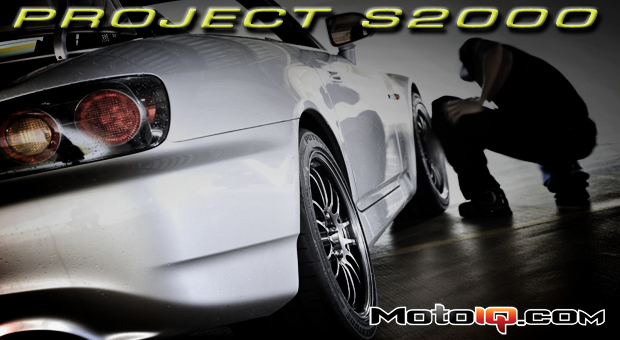,
 |
| Some extra hardware is required to be bought: M10 x 1.5 flanged nuts/nuts and washers (two per corner, stock have a finer thread pitch), and M8 x 1.25 nuts and lock washers (2 sets for the brake lines on the front shocks). |
KW completely addresses perhaps the most critical issue that coilovers usually have on street cars, shock body thread corrosion where the spring seat rusts solid to the shock body. Typically the spring seat is made of a different metal than the shock body. This causes galvanic corrosion between the body and seat sticking it solid. KW addresses this issue by using stainless steel for the shock body. The spring seat is made of a corrosion proof engineering super plastic. This makes for a coilover body that is always silky smooth in adjustment and will never corrode, even in salty east coast winters!
 |
| We removed the rear chassis brace to ease access to the two nuts on the top of each damper (caution, it was a royal PITA to get the chassis brace back on). |
To dial in the damping characteristics of the suspension setups, KW has a 7-post suspension dyno. It can operate in 4-post (basic setup), 6-post (with aerodynamic loading) and 7-post (aero, lateral and other body loading) modes. To operate in 7-post mode, a complete set of data recording all loadings must be datalogged for each specific vehicle configuration on the racetrack. Once that data is available, it is input into the 7-post dyno which replicates the exact loading seen on the racetrack. This allows for extremely repeatable testing enabling KW to see exactly how the smallest changes affect the suspension calibration.
 |
| The driver’s side rear is especially tight on space with the fuel filler tubes being located there. We removed the three nuts in the gas cap area to allow movement of the tubes. Lastly, a wobble joint comes in handy here. |
The Clubsports use 100 N/mm (571 lb/in) springs versus the V3’s 80 N/mm (457 lb/in) springs. The higher spring rate is better able to handle higher grip tires typical of track day cars. The aluminum uniball mounts replace the stock upper mounts used on the V3s; the uniball mounts eliminate the cushy rubber (that provide a more comfy street ride) thereby eliminating unwanted suspension geometry changes that affect handling precision. Lastly, the Clubsports get KW’s high-performance springs. These springs are made from a higher performance and tempered steel alloy allowing the springs to be made from less material. Compared to a regular spring, for a given spring length, this means there is more suspension travel (reduced coil-bind height) and less weight.
 |
| The Whiteline front sway bar is a nice piece with clean accurate bends and forged one piece ends. |
 |
| Whiteline urethane swaybar bushings get rid of compliance and give better feel. The Whiteline sway bar bushings are grooved on the inside to retain the grease. It’s a nice feature! |
The stock 2005 AP2 spring rates are 266f/273r lb/in. The KWs use equal rate springs front and rear which should shift the handling balance a tiny bit towards understeer. However, this is not nearly the same amount of shift in balance compared to the change created by the larger front tires. One no-brainer in the setup is using a stiffer front anti-roll bar. On the recommendations of Robispec’s Rob Fuller, we picked a new front bar from Whiteline. The Whiteline anti-roll bar is a stout 30mm in diameter compared to the stock 27mm which equates to a 50% increase in roll resistance compared to stock. The non-adjustable bar is CNC bent for accurate end link heights with forged one piece ends. The Whiteline bar also replaces the compliant rubber bushings with polyurethane. We wrapped the bar with Teflon tape and then used the supplied Whiteline grease to eliminate the chances of the bar squeaking. The bar is powdercoated for corrosion resistance and uses the stock Honda spherical ball end links since they are already pretty non compliant.
 |
| I used the teflon tape trick on the sway bar that I learned from the MotoIQ Evo X project. |


